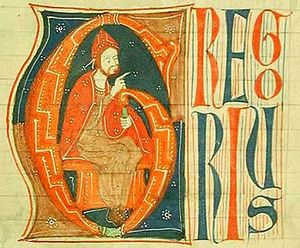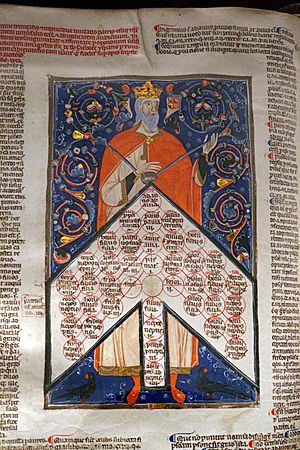Pope Gregory IX facts for kids
Quick facts for kids Pope Gregory IX |
|
|---|---|
| Bishop of Rome | |

Gregory IX in a manuscript miniature c. 1270
|
|
| Church | Catholic Church |
| Papacy began | 19 March 1227 |
| Papacy ended | 22 August 1241 |
| Predecessor | Honorius III |
| Successor | Celestine IV |
| Orders | |
| Consecration | c. 1206 |
| Created Cardinal | December 1198 |
| Personal details | |
| Birth name | Ugolino di Conti |
| Born | between 1145 and 1170 Anagni, Papal States |
| Died | 22 August 1241 (aged 70~96) Rome, Papal States |
| Previous post |
|
| Coat of arms | |
| Other Popes named Gregory | |
Pope Gregory IX, born Ugolino di Conti, was a very important leader of the Catholic Church. He was the head of the Church and also ruled the Papal States (lands controlled by the Pope) from 1227 until he died in 1241. He is remembered for creating a set of Church laws called the Decretales. He also started the Papal Inquisition, which was a system to investigate and deal with heresy (beliefs that went against Church teachings).
Gregory IX followed in the footsteps of previous popes, especially his cousin Innocent III. He strongly believed in the Pope's authority over kings and rulers.
Contents
Early Life and Church Career
Ugolino di Conti was born in Anagni, a town in Italy. We don't know his exact birth year, but it was sometime between 1145 and 1170. He studied at famous universities in Paris and Bologna, which were important centers of learning.
His cousin, Pope Innocent III, made him a Cardinal-Deacon in 1198. This was an important position in the Church. Later, in 1206, he became a Cardinal Bishop. He also became the leader of the group of cardinals in 1218 or 1219.
Ugolino was a good friend to Saint Francis of Assisi, who founded the Franciscans. Pope Honorius III even asked Ugolino to be a special protector for the Franciscan order.
Becoming Pope and Key Decisions
Gregory IX became Pope in 1227. He chose the name "Gregory" because he officially took on the role at a monastery named after Saint Gregory. One of his first actions as Pope was to expand the powers of the Medieval Inquisition in Germany. This was to help investigate heresy more widely.
Supporting Universities
In 1231, Pope Gregory IX issued an important document called Parens scientiarum. This document helped solve problems between the students and leaders of the University of Paris and the local city officials. Gregory IX took the university under his direct protection. His rules allowed the university to stop lectures if they faced serious problems. This document is sometimes called the "magna carta" of the University of Paris.
The Papal Inquisition
In 1233, Gregory IX set up the Papal Inquisition. This was meant to make the process of dealing with heresy more organized and fair. Before this, local church leaders sometimes handled heresy cases in a messy way. Gregory wanted to bring order and proper investigation to these cases. He appointed special Dominican and Franciscan priests as Papal Inquisitors in different parts of Europe. Their goal was to ensure a fair process and objective investigation for those accused of heresy.
New Church Laws
Gregory IX was a very skilled lawyer. He ordered the creation of a new collection of Church laws called Nova Compilatio decretalium, which was published in 1234. This book brought together many Church rules and decisions that had been made over hundreds of years. It became a very important foundation for Church law.
In 1234, Gregory also called for a new crusade to the Holy Land. This led to the Barons' Crusade in 1239.
In 1239, Gregory ordered that all copies of the Jewish Talmud be taken away. After a public debate in Paris, about 12,000 handwritten Talmudic books were burned in 1242.
Supporting Religious Orders
Gregory IX was a strong supporter of new religious groups like the Dominicans and Franciscans. He believed their simple lifestyle helped fight against too much luxury in the Church. He was a personal friend of Saint Dominic and Clare of Assisi. He also approved the Order of the Blessed Virgin Mary of Mercy, which helped free captives. He made several people saints, including Elisabeth of Hungary, Dominic, Anthony of Padua, and Francis of Assisi.
Gregory IX also supported the Northern Crusades, which were efforts to spread Christianity in Eastern Europe. In 1232, he asked a group of knights to help protect Finland from attacks.
Conflict with Emperor Frederick II
The Crusade Vow
Gregory IX had a long and difficult conflict with the Holy Roman Emperor Frederick II. When Frederick II was crowned in 1220, he promised to go on a Sixth Crusade to the Holy Land. However, he kept delaying.
When Gregory IX became Pope, he suspended Frederick II from the Church for not keeping his promise. This means Frederick was temporarily not allowed to participate in Church sacraments. Frederick II complained to other European rulers about this. The Pope then went further, officially excommunicating Frederick and even threatening to remove him from his position as Emperor.
Frederick II eventually went to the Holy Land and managed to gain control of Jerusalem through a treaty. However, Gregory IX still did not trust him. While Frederick was away, an imperial governor had invaded lands belonging to the Pope. When Frederick returned in 1229, he defeated the Pope's army and then tried to make peace. This conflict was known as the War of the Keys.
Renewed Conflict
Gregory IX and Frederick II made a temporary peace. But when Frederick defeated the Lombard League (a group of northern Italian cities) in 1239, he became very powerful in Italy. This worried the Pope because Frederick's lands would surround the Papal States.
This led to new fighting. Gregory IX again excommunicated Frederick II in 1239 and called a special meeting of Church leaders in Rome to discuss the matter. Frederick responded by trying to stop or sink ships carrying these leaders to the meeting.
The conflict between Pope Gregory IX and Emperor Frederick II continued until the Pope's death on August 22, 1241. The struggle was eventually finished by Gregory's successor, Pope Innocent IV, who called for a crusade against Frederick II's family.
Images for kids
See also
 In Spanish: Gregorio IX para niños
In Spanish: Gregorio IX para niños
- Regulæ Juris
- Vox in Rama
- Cardinals created by Gregory IX
- Pope Gregory IX and Judaism
| Catholic Church titles | ||
|---|---|---|
| Preceded by Ottaviano di Paoli |
Cardinal-bishop of Ostia 1206–1227 |
Succeeded by Rinaldo di Jenne |
| Preceded by Nicola de Romanis |
Dean of the College of Cardinals 1218-1227 |
Succeeded by Pelagio Galvani |
| Preceded by Honorius III |
Pope 1227–41 |
Succeeded by Celestine IV |



